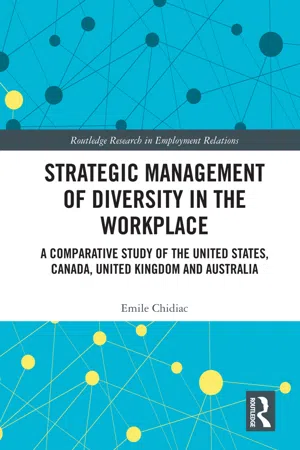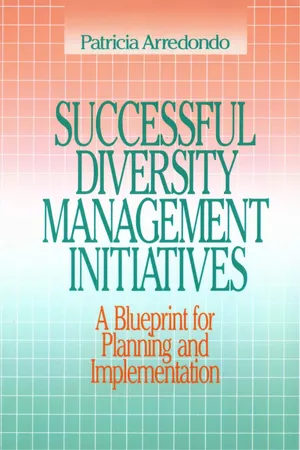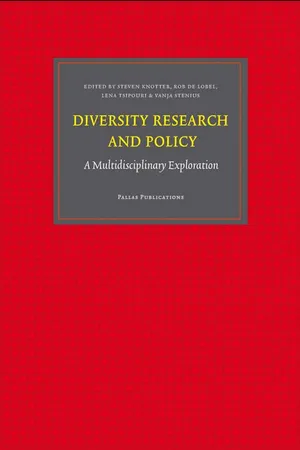Business
Diversity Management
Diversity management involves creating an inclusive work environment that values and leverages the differences among employees. It encompasses policies, practices, and programs aimed at fostering a diverse and equitable workplace. Effective diversity management can lead to improved employee satisfaction, innovation, and overall business performance.
Written by Perlego with AI-assistance
Related key terms
1 of 5
9 Key excerpts on "Diversity Management"
- eBook - ePub
Strategic Management of Diversity in the Workplace
An Australian Case
- Emile Chidiac(Author)
- 2018(Publication Date)
- Routledge(Publisher)
The rise of Diversity Management has developed significantly in the history of the workplace, and the shift from equal opportunity to Diversity Management ‘meant a shift from the ethical and legal case to business case arguments’ (Tatli 2011, 242). The spread of Diversity Management was rapid and ‘by the late 1980s, equal employment opportunity/affirmative action (EEO/AA) specialists were recasting EEO/AA measures as part of DM [Diversity Management] and touting the competitive advantages offered by these practices’ (Kelly and Dobbin 1998, 972). The shift from equal opportunity to Diversity Management and beyond led to new terms being coined, with some researchers adding the concept of inclusion to denote a shift from removing obstacles to organisational belonging and full participation. When employees feel included, they tend to feel part of the organisation by having access to information and sharing in decision making. While Diversity Management is introduced in organisations voluntarily and implemented in various ways, it must be operated with appropriate and pertinent national legislation, such as anti-discrimination and industrial relations law (Klarsfeld 2010). In addition, managing diversity is different from AA because it is a voluntary corporate approach concerned with increasing heterogeneity in the workplace, instead of being imposed by the government (Ng and Burke 2005).Strategic management of diversity in action shows how managers use diversity to manage the workforce and reinforce class relations. Strategic Diversity Management is broadly defined as a planned commitment by organisations to employ, retain and promote a heterogeneous group of employees (Henry and Evans 2007). Stuber (2009) conceptualised Diversity Management as a principle consisting of four main components: diversity, respect, inclusion and added value. Cox and Blake (1991) defined the concept as referring to various management issues and activities pertaining to the hiring and effective use of employees from different cultural backgrounds. The concept is also defined as:the strategic alignment of workforce heterogeneity to include and value each employee equally on the basis of their diverse characteristics, and to leverage organisational diversity to enhance organisational justice and achieve better business outcomes.(Ozbilgin et al. 2011, 27)Therefore, Diversity Management should be seen as managerially initiated programs and/or HRM policies and practices aimed at empowering the diverse workforce through effective integration to increase business productivity. Thus, Diversity Management is a process of managing people’s similarities and differences, and recognising that employees’ differences in the workplace represent a potential strength. At the same time, the existence of diversity among groups of people arises from differences in both culture and structure. These differences affect perceptions, feelings and attitudes. This adds to the needs and expectations of different management styles for different cultures, including language, custom, conventions and normative behaviour (DiTomaso 1999). - eBook - PDF
Successful Diversity Management Initiatives
A Blueprint for Planning and Implementation
- Patricia Arredondo(Author)
- 1996(Publication Date)
- SAGE Publications, Inc(Publisher)
Basic principles of diversity man-agement are briefly introduced below to provide the knowledge base required by leaders, diversity planners, and decision makers. Diversity Management Is the Key to Promoting Dignity and Respect in the Workplace and a Framework for Positioning People as a Necessary Factor to Organizational Success. Diversity Management will have a secure position in the realm of business management for the foreseeable future. As the diversity of people will always exist, so will the need to work with factors of change. These factors of change will be both internal and external, and domestic and international, driven by need as well as potential for emerging markets. In my work, I have found that a workplace with a humanistic culture and ambiance conveys a message of value to employees. After deliberate interventions designed to pro-mote individual empowerment and personal value, I have recorded shifts in people's motivation, morale, and desire for improved perform-ance. Though always considered a soft area, attention to the people factor needs to be positioned as central and key to success (Cox, 1993; De Pree, 1992; Smith, 1993; Walton, 1990). 20 SUCCESSFUL Diversity Management INITIATIVES Diversity Management Is a Strategic Organizational Goal. Diversity Management interacts with all other aspects of business, that is, leader-ship, management practices, product development, human resources, marketing and sales, financial projections, and community and global communications. For example, let us consider two business realities: health care services have become a very competitive commodity. Or-ganizations' marketing and sales plans are typically designed to get the consumer's attention with the expectation that people will be moti-vated to buy the service or goods. Cultural and linguistic considerations now weigh in as critical factors, as the following example indicates. - eBook - ePub
Diversity
A Key Idea for Business and Society
- Mustafa F. Özbilgin(Author)
- 2023(Publication Date)
- Routledge(Publisher)
CHAPTER 6THE MANAGEMENT OF DIVERSITYDOI: 10.4324/9780367824044-7All societies and organisations have always managed diversity, sometimes with contempt, caution and scepticism and sometimes with interest, curiosity, support and solidarity. In the last 30 years, diversity has become a management and leadership concept that is widely recognised and used internationally. The move from equal opportunities, human rights and employee welfare programmes to Diversity Management has been considered a paradigmatic shift by some scholars, while others attributed this shift to changes in the macro socio-political and socio-demographic context and liberalisation of difference in the context of the workforce. Whatever the reasons for it may be, Diversity Management is now an established field of professional work. In many global and national organisations across all sectors of work and industry, there are units or individuals responsible for diversity and inclusion. In this chapter, we explore the professional practice of Diversity Management.THE STRATEGIC APPROACH TO MANAGING DIVERSITY
Diversity Management is reportedly a strategic concern for organisations today (Thomas, 2016 ). This shift is because demographic diversity had meteoric growth due to several global changes. First, the advent of communication and transportation technologies made heterogenous encounters possible among people from different parts of the world. Expansion and democratisation of education internationally contributed to the growth of diversity in available talent. Further, the growth of the reach of global organisations and the expansion of their value chains worldwide have facilitated people from diverse backgrounds to work together. Similarly, the rapid expansion of knowledge and service sectors has highlighted the significance of human interaction and teamwork and diversity within this interaction, particularly for the sustainability of these sectors. In this context, Diversity Management emerged as a series of management interventions to better use diversity among people at work, both as workers and as customers. From product and service design to management of people to delivery and consumption of products and services, Diversity Management approaches made significant contributions to the way we manage modern organisations. However, Alcázar et al. (2013) explored whether human resource management strategies adequately consider workforce diversity. Their findings show that strategic human resource management does not capture diversity requirements. OECD’s (2020) - eBook - PDF
Global Diversity Management
An Evidence-Based Approach
- Mustafa Ozbilgin, Ahu Tatli, Karsten Jonsen(Authors)
- 2017(Publication Date)
- Red Globe Press(Publisher)
As shown above, diversity definitions differ significantly between studies and authors. In essence, definition typologies can be used as different ways to frame the understanding of and the approach to diversity. For example, Noon and Ogbonna (2001) mention diversity as ‘a neutral descriptor of variation within INTRODUCTION 3 the workplace’. This approach can be contrasted with more value-loaded defini-tions that imply particular advantages or aims of the diversity policy (such as eliminating discrimination). Mor Barak (2005, p. 208) defines Diversity Management as ‘the voluntary organizational actions that are designed to create greater inclusion of employees from various backgrounds into the formal and informal organizational struc-tures through deliberate policies and programs’. The same author also defines international Diversity Management and cross-national Diversity Management by referring to ‘the management of a workforce consisting of different citizens and/or immigrants’ (ibid., p. 209). Defining and interpreting Diversity Management has been a tall order. Although Diversity Management can be defined simply as a management philos-ophy that seeks to recognize and value heterogeneity in organizations, the key difficulty has been in interpreting this definition, due to the multiplicity of vested interests by multiple stakeholder groups over the aims, processes and proposed outcomes of Diversity Management, as well as what constitutes legiti-mate, assumed and real forms of heterogeneity in organizational settings. The Diversity Management approach has also been critiqued; for example for being opportunistic and dissolving the basis of disadvantage which could help those groups in particular (e.g. Liff and Wajman, 1996) and for being predom-inantly semantic. - eBook - PDF
Women in Management
Current Research Issues Volume II
- Marilyn J Davidson, Ronald J Burke, Marilyn J Davidson, Ronald J Burke(Authors)
- 2000(Publication Date)
- SAGE Publications Ltd(Publisher)
It wil l not be viewed as something in favour of minorities and against whites. It will, how-ever, be normal to be different and equal opportunities principles will be integrated into the values of an organization. ( 1 992: 55) But the key development that has arisen from the business case and changing demographic trends is that of managing diversity. This approach, whilst claiming to be distinctive from conventional approaches to EO, offers to enhance the work-ing lives and opportunities of women managers. Managing diversity One example of a clearly defined approach using a business case is a set of inter-ventions based upon the effective management of diversity in organizations. The management of diversity presents a business case for moving towards a diverse workforce where the skills of all groups are recognized. The argument is that given the current shortage of skilled labour (particularly in the United States) the effective use of diverse skills within an organization makes good business sense. Diversity Management is particularly popular in the United States where the skill shortages are more pronounced than in Britain. Management of diversity is based on the notion of difference and the effective management of difference. Valuing difference is seen as an important concept because it is specif ically linked to an organization's culture and values. A key element is to move towards 'cultures of inclusion' (Thornberg, 1 994) recognizing that various organizational practices often lead to certain groups feeling left out or unwelcome. Exponents of the man-agement of diversity perspective (Thomas, 1990; Cox, 1992; Jackson et aI., 1992; Kandola and Fullerton, 1 994) argue that all differences must be valued including those of white males. - eBook - PDF
Intercultural Communication
An Interdisciplinary Approach: When Neurons, Genes, and Evolution Joined the Discourse
- Mai Nguyen-Phuong-Mai(Author)
- 2017(Publication Date)
- Amsterdam University Press(Publisher)
Good diversity policies can turn cultural dif ferences into strengths and benef its. Hence, Diversity Management has moved to the top of the organizational development agenda. What began as token initiatives to meet legal requirements have now become strategic programs aimed at achieving organizational outcomes. This strategy mindset captures the es-sence of Diversity Management, which has been def ined as a “management philosophy of recognizing and valuing heterogeneity in organizations with a view to improve organizational performance.” 1 In short, it is not diversity for the sake of diversity, but an acknowledgement that it should be seen as a performance driver and a business imperative. 7.1.1 The Drivers of Workforce Diversity Managing a diverse population and workforce is not new. Indeed, great empires throughout history have conquered lands comprised of fragmented peoples and nations, yet learned to rule them ef fectively for centuries. 2 250 INTERCULTURAL COMMUNICATION However, the kind of Diversity Management we are witnessing today is driven by historical factors that characterize the fast-changing pace of the modern era. 7.1.1.1 Social Movements Although the term “Diversity Management” came into use in the 1980s, the overall movement was a response to the social protests, civil rights and af firmat ive legislation that emerged after the Second World War. 3 Historical court rulings and women’s liberation movements shaped the way organiza-tions addressed the racio-ethnic diversity of the workforce. In 1954, the US Supreme Court overturned the 1896 separate-but-equal doctrine and ordered desegregation of public schools soon after. Whereas first-wave feminism focused on voting rights, the second wave spread through Europe in the 1960s and 1970s and broadened to include equal opportunities at work, reproduction rights and the freedom of choice in sexuality. - eBook - PDF
Diversity Research and Policy
A Multidisciplinary Exploration
- Steven Knotter, Rob de Lobel, Lena Tsipouri, Vanja Stenius, Steven Knotter, Rob de Lobel, Lena Tsipouri, Vanja Stenius(Authors)
- 2012(Publication Date)
- Amsterdam University Press(Publisher)
The term ‘management’ has its roots in the Italian word ‘maneg-giare’, which means “to handle a horse”. This etymology reveals its action- and goal-oriented connotation, involving taking responsibility for, and control of, someone or something else (Alvesson & Willmott 1996). e Meaning and Categorisation of Diversity in Organisation and Management Studies Despite its relatively recent introduction in organisation studies, diversity has become a popular topic among Western managers, practitioners and scholars over the last fifteen years (Maxwell, Blair & McDougall 2001, Nkomo & Cox 1996, Nkomo & Stewart 2006, Prasad & Mills 1997). The term generally re-fers to differences in people’s identities “based on membership in social and 160 Diversity Research and Policy demographic groups” (Nkomo & Cox 1996: 339) such as ethnicity, gender, race, sexual orientation and physical ability. However, diversity can also be understood more broadly, including dimensions such as lifestyle, educational background, work experience, cognitive style, and even personality (Nkomo & Cox 1996, Prasad, Pringle & Konrad 2006, Zanoni & Janssens 2004, see also Bechtoldt in this volume). Diversity Management and managing diversity refer to programmes and actions that organisations set up to recruit, retain and manage diverse employees and to create a context in which everybody can perform and contribute to the organisation (Litvin 2002, Mavin & Girling 2000, Prasad & Mills 1997). e Historical Origins of Diversity Interest in the topics of diversity and Diversity Management emerged in the late 1980s in the US, when the Workforce 2000 Report of the Ministry of La-bor ( Johnston & Packer 1987) warned that the US workforce was becoming more diverse, and that the relative amount of white men in the labour market would decrease (Billing & Sundin 2006, Kelly & Dobbin 1998, Konrad 2003, Nkomo & Cox 1996, Maxwell et al. 2001, Prasad & Mills 1997). - eBook - PDF
- Michael A. Hitt, C. Chet Miller, Adrienne Colella, Maria Triana(Authors)
- 2017(Publication Date)
- Wiley(Publisher)
Because of the effective management of diversity, there is little intergroup conflict. Deloitte states on its Diversity and Inclusion website: “We are all unique. Each one of us is different from anyone and everyone else. All those differences that make each of the multicultural organiza‑ tion An organization in which the organizational culture values differences. Affirmative Action Diversity Management Purpose To prevent and/or remedy discrimination To create an inclusive work environment where all associates are empowered to perform their best Assimilation Assumes individuals will individually assimilate into the organization; individuals will adapt Assumes that managers and the organizations will change (i.e., culture policies and systems foster an all-inclusive work environment) Focus Recruitment, mobility, and retention Creating an environment that allows all associates to reach their full potential Cause of Diversity Problems Does not address the cause of problems Attempts to uncover the root causes of diversity problems Target Individuals identified as disadvantaged (usually racial and ethnic minorities, women, people with disabilities) All associates Time Frame Temporary, until there is appropriate representation of disadvantaged groups Ongoing, permanent changes Sources: Society for Human Resource Management, “How Is a Diversity Initiative Different from My Affirmative Action Plan?” (2004), http://www.shrm. org/diversity; Adapted from R. R. Thomas, Jr., 1992; “Managing Diversity: A Conceptual Framework,” in S.E. Jackson et al. (eds.), “Diversity in the Work- place” (New York: Guilford Press), pp. 306–317. EXHIBIT 2‑1 Differences between Affirmative Action Programs and Diversity Management Programs 38 CHAPTER 2 Organizational Diversity individuals working at Deloitte Touche Tohmatsu Limited and the member firms unique rep- resent many dimensions of diversity—and this diversity is Deloitte’s greatest strength.” 17 It’s a business imperative. - eBook - PDF
- Alison M Konrad, Pushkala Prasad, Judith Pringle, Alison M Konrad, Pushkala Prasad, Judith Pringle(Authors)
- 2005(Publication Date)
- SAGE Publications Ltd(Publisher)
Models with intervening variables such as business strategy, HRM strategy and organizational environment should be tested to ascertain the effect of diversity on organizational performance. Future research on organizational-level impacts might examine questions such as the following: Does including ‘valuing diversity’ in the mission statement elicit organizational unity and commitment? If so, does this facilitate a more favorable multicultural environment that yields stronger business results? Do organizations that value diversity because of the moral imperative do better on measures of organizational effectiveness, relative to those that value diversity because of the ‘business case’? THEORETICAL PERSPECTIVES ON WORKPLACE DIVERSITY 68 CONCLUSION Today, there is a wide spectrum of organizational response to managing diversity. There are some organizations responding to legal mandates; others are focused on discrete programs and policies; still others are implementing broad HR diversity strategies to foster change in culture and work processes. In 2002, SHRM conducted a survey jointly with Fortune magazine to examine how the Post 9/11 economic challenges faced by many firms had affected diver-sity efforts. Although there were slight shifts, the 2002 survey showed that corporate spending on diversity initiatives remained constant, with even slight increases in funding for diversity training related to race and ethnicity (www.shrm. org/diversity/TalkingtoDiversityExperts.pdf). In general, while most US multinationals have established diversity programs, a private research report indicates they are only beginning to establish parallel efforts in their overseas affiliates and subsidiaries. Most efforts are currently cosmetic and off-the-shelf US approaches that will likely be ineffective in the European Union (Eagan & Bendick, 2001). Around the world, valuing diversity faces competition from many other pressing HR issues (Wheeler, 1995).
Index pages curate the most relevant extracts from our library of academic textbooks. They’ve been created using an in-house natural language model (NLM), each adding context and meaning to key research topics.








